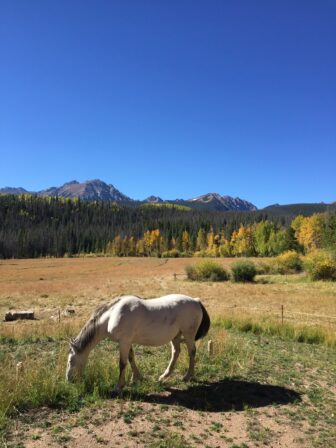Colorado Caper
I tend to make snap decisions about how I feel about places or things, but I often find out I was wrong. Since I skied in Aspen in the late 50s, I assumed Colorado was a place for skiing, period. I never thought of it in terms of anything else. I knew they had wildfires, mountains and lots of good water which we no longer receive. For me Colorado was a passive place where activities occurred. However, we just returned from a week in Colorado, and how mistaken was I!
We flew to Denver, rented a convertible (for the same price as the SUV the rental agent insisted we needed for our mountainous journeys), and drove to Colorado Springs for a wedding. I relished the clear, dry, 72 degree air and noticed the terrain was definitely mountainous. Since we were anxious to find our way, much of my time was spent playing with the GPS (I have NO sense of direction) and looking at the map. The two rarely agreed.
The morning of the wedding we went sight-seeing. I actually saw the scenery. We took a short walk looking at the incredible rock formations. Small holes dotted one large red rock formation. These are apparently where bats hang out in the daytime. We saw signs warning us to stay on the paths as the wildlife (rattlesnakes) had the right of way everywhere. We didn’t see any wildlife at that point.
Colorado Springs had a devastating wild-fire a few years ago. We noticed beautiful trees abutting forests of burnt skeletons of trees. The bride’s family home was spared in the fire; their next door neighbors were not as lucky. The aftermath of the fire is still highly visible.
After a weekend of wedding festivities, we set off for higher elevations from Colorado Springs to Silverthorne. Colorado Springs’ elevation is about 6000 feet; Silverthorne’s is about 8730. Silverthorne is a tiny village with second homes abounding. However, it is covered with fir and quaking aspen which provide an interesting and magnificent landscape. I grew up in the Mid-West with sugar maples and oak trees bursting into flamboyant reds and yellows in the fall. The East Coast also teems with these trees. I assumed Colorado would be less exciting. Was I mistaken!
A bit above the 6000 foot elevation, aspen flourish. Luckily we arrived at the higher elevations at the peak of the color season. There were no red leaves, but gradually I was seduced. Aspen leaves turn neon yellow. Some even have a reddish tinge to their leaves. The colors are supposed to be specific to each tree, but I noticed that huge expanses of one color would be dotted by a smaller expanse of another.
Aspens are unusual. They are comparatively short-lived (20-100 years per Google) and while they can reproduce by seed, they usually reproduce by sending shoots under the ground. In Silverthorne, the newspaper refers to this as “cloning.” According to an article by Karen Carter for Demand Media, The quaking aspen is dioecious, which means that trees are either male or female. Each gender produces different types of flowers. Nursery and garden centers sell the trees as either male or female. Only the female tree produces fruit when the flowers are fertilized by a nearby male tree. Clones or root sprouts produce saplings that are the same gender as the parent tree.
While aspens are prone to a host of diseases, even wildfires don’t diminish their presence thanks to these “shoots.” Fast growing, the shoots pop up with a new forest after the fires have ceased. In a planned landscape, however, aspen can be invasive.
Aspens also have beautiful bark. Apparently it has some pain relieving properties, but the bark resembles birch bark with a pale green sheen. I read that photosynthesis continues in the trunk and limbs of the aspen into the winter. Beaver love to build lodges and dams with aspen and willow. Moose and deer find the bark delicious and often leave a distressed aspen after a meal.
The leaves shimmer in sunlight making them appear to shiver and quake. They are shiny, thin and lightweight which causes the slightest breeze to set them dancing.
I really fell in love in Silverthorne. Not only were the vibrant aspen a terrific contrast to dark fir and skeletons of other firs killed by an infestation of beetles, the ambiance of the area was relaxed and homey. Since not many people live there year round, those who do are incredibly friendly, always ready to lend a helping hand. We stayed with friends who relocated there from San Diego. The meadow adjoining their property is the summer home of five horses: Charlie, Peach, Fox, Broom, and Tock.
We had the pleasure of helping to move them from their summer pasture to their home up the road. The horses were scheduled for pedicures, and the farrier was ready when we arrived. I was sad on my final morning. The previous day, Fox had come to my bedroom window to wake me up. I heard that the horses managed to escape. First they went to their owners’ home. Then they returned to the summer pasture. Once more they were led to the wintering barn and paddock.
I loved the places I saw in Colorado. I loved the temperature and the lack of humidity. I never saw (but I didn’t look, either) a marijuana shop; I did see outlet stores. Our Colorado visit was a lovely vacation.
November’s Mission Hills Garden Club meeting will be a party for members; our next meeting will be in January.
Category: Featured Articles








